- Blog
- 14 Ecommerce Tips to Boost Sales for Small Businesses
14 Ecommerce Tips to Boost Sales for Small Businesses
-
Nikolett Lorincz
- Ecommerce
- 6 min read
Table of Contents
The ecommerce industry is an ever-changing business. It’s part of a digital world that’s been continuously evolving since its creation. And not only that, but we access the web through devices that are becoming more advanced and practical—each and every day.
An online store needs to keep up with all these changes in order to stay relevant.
But some things never change.
Ecommerce businesses will always need to:
- Make a good first impression
- Take care of their customers
- Reach them where they are
These best practices are essential for any business.
In this article, we’ll explain the most up-to-date ecommerce tips for accomplishing these timeless goals.
Let’s dive right in!
1. Make a good first impression on customers
Customers form a first impression about your ecommerce store very quickly. In fact, it only takes people about 50 milliseconds to decide if they like your site or not.
This moment is essential because you can only make a first impression once.
Ecommerce stores need to be as creative as possible to win lifelong customers.
An investment in the best possible site design is the first step towards improving the user experience.
You should also get your store onto a reliable ecommerce platform like BigCommerce or Shopify. These platforms make it easy to create a clear, logical structure for your online store.
In order to awe your customers, it’s also important to use the right popup templates at the right time.
For example, you shouldn’t bombard new visitors with welcome popups. Give them some time to explore your site before you start showing your discounts (for more popup tips, check out this article).
However, small, unobtrusive popups can improve customer engagement and experience. For example, a sidemessage is a great way to guide incoming visitors, just like Natural Vital did:

Check out these popup templates if you’d like to create a campaign that makes a good first impression on your online store visitors:
2. Be customer-centric
An ecommerce business is more remote from customers and not as accessible as a brick-and-mortar store. Your customers can’t touch, feel, or try on your products before making a purchase.
While there’s no solution for this issue, you can make up for it in a few different ways.
The fact that it’s simply more convenient to buy from a website than go all the way into a store should be your jumping-off point.
However, that’s not enough.
You need to show that you value your customers. For example, you could offer a fair price on all your products or free shipping. Also, it should be easy and simple to complete the entire purchase process—from selection to checkout.
Having stellar customer service is another way to show that you value your customers. So ensure you invest in excellent customer service and equip your team with an efficient cloud contact center software that will enable them to provide the best on-the-phone customer experience.
Make sure that people come away from interacting with your business with positive feelings.
Take these extra steps to keep your online shoppers engaged with your site and product pages. It will pay off and motivate them to make a purchase.
But don’t forget to keep your customers engaged after their purchase, too. For example, effective e-commerce fulfillment strategies can make returns easier for customers. And that’s important, as customers who can easily return products are less likely to issue chargebacks or leave negative reviews.
3. Be mobile-friendly
One of the ecommerce business tips we keep returning to is the importance of mobile.
Simply put, in today’s world, you’re irrelevant if you aren’t building your ecommerce business with mobile in mind.
Luckily, it’s easy to check whether or not your website looks as good on mobile devices as it does on desktops.
Google has a free mobile-friendly test tool that shows what your site looks like on mobile. It also suggests what improvements you can make to your site.
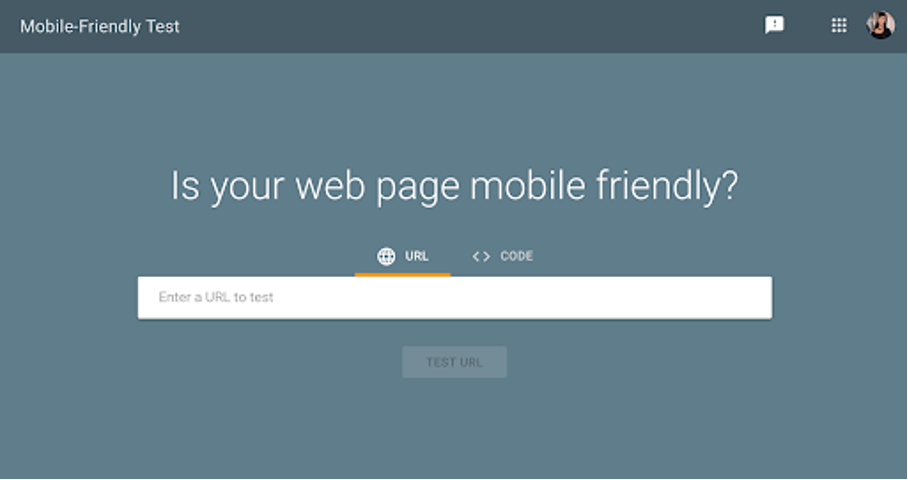
When optimizing your ecommerce business for the best possible experience, ask yourself questions like:
- How will your navigation work on different devices?
- Are clickable elements easily tappable?
- Are your images beautiful on all screen sizes?
- Is the add-to-cart, checkout, and payment workflow optimized for different screen sizes?
4. Align your business with social media
Social media should be close to the heart of your ecommerce brand.
Social media pages like Facebook, Instagram, and Twitter can allow you to grow brand awareness and your customer base. As long as you use them well.
Utilizing eye-catching designs can enhance the visual appeal of your posts, making them more shareable and engaging for your target audience.
OrangeTwig is a tool that helps you do just that. It’s a social media marketing app that lets you put items in your store on sale. And it automatically promotes them via their stunning layouts.
Here are a few tips to help you establish your brand across social media platforms:
- Post regular content, daily stories, and weekly live content.
- Comment on and like competitors’ highly engaged followers.
- Follow accounts that follow your competitors since you know they are interested in your business.
- Leverage influencer marketing.
ColourPop is a great example of a company that rode social media to succeed. They are a cosmetics company that grew from a small business to a global brand through a clever and innovative social media marketing strategy.
Check out our breakdown of their success for some tips for ecommerce marketing!

5. Use more photos
Humans are visual creatures. In fact, we process visuals 60,000 times faster than text.
Take advantage of this by filling your landing page with visual content.
And luckily, this is one of the easiest ecommerce tips to follow. Just go ahead and add more pictures to your site.
Check out how Lululemon uses images on their homepage:
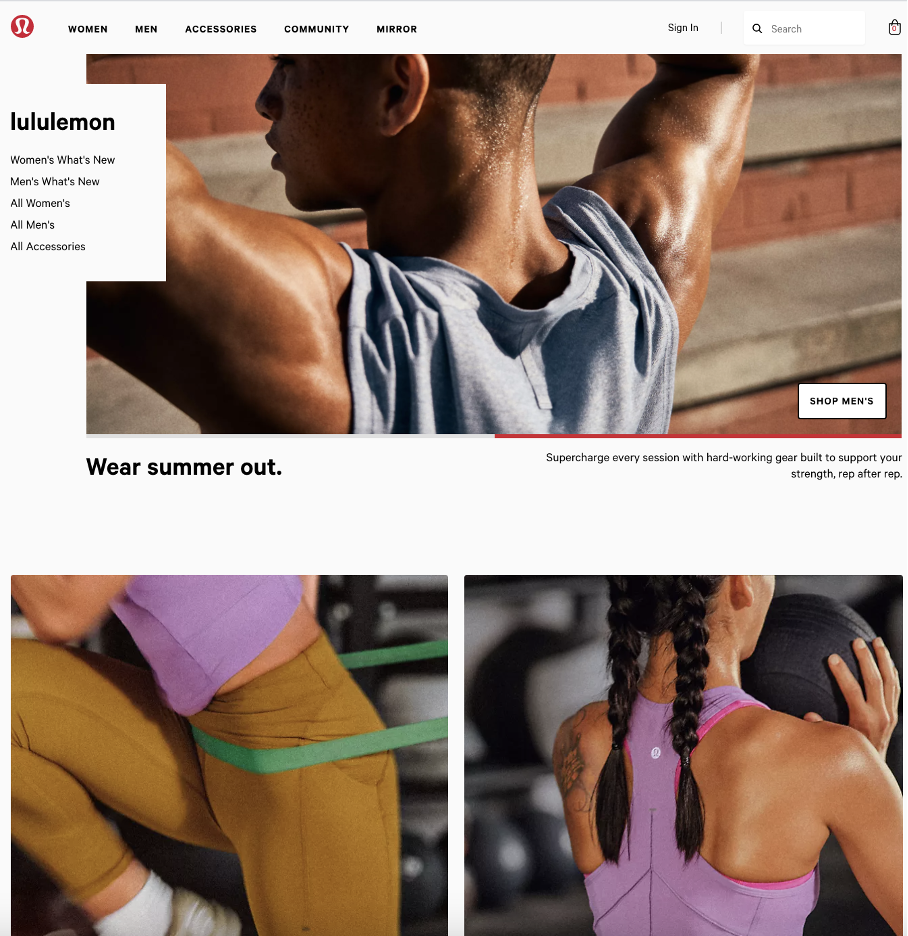
6. Stay on top of SEO
Bring potential customers to your site with engaging and informative blog posts.
Search engine optimization (SEO) is the science of making sure your content ranks highly when searching for a related term on search engines like Google or Bing.
It’s incredibly important to use SEO strategies because 90% of the users never make it beyond the first page of results.
Here are some SEO optimization strategies that can help grow your incoming search traffic:
- Optimize your title, URL, and meta-description to hit the keywords that people are searching
- Provide high-value content and keep it fresh
- Improve your website’s loading time
- Implement Google authorship
- Register your website with Google and Bing business webmaster tools
- Take advantage of AI by using ChatGPT for SEO
7. Use live chat
Adding live chat software to your website is one of the most significant improvements to the shopping experience.
Here are some stats to consider:
- 77% of customers won’t make a purchase if there’s no live chat support
- 73% of customers find live chat to be the most satisfying way of communicating with a business
- 63% of consumers are more likely to return to a website that offers live chat
This means that live chat can help your potential customers make a faster and more comfortable decision. That way, a customer feels like they have every information they need at their fingertips.
Your users should feel like they’re interacting with humans—not a machine. Live chat is the solution to humanizing your site.
It makes people feel like they’re in a real store where they can get all of their questions answered by a shop assistant.
If you use Sendpulse, Intercom, or similar software, you can even combine live chat and chatbot functionally.
Place your live chat button in a highly visible spot, so it’s easy to notice. It’s also a good idea to keep the button visible at all times—even when the user is scrolling or reading a product review.
Bailly uses a specific live chat for new visitors:
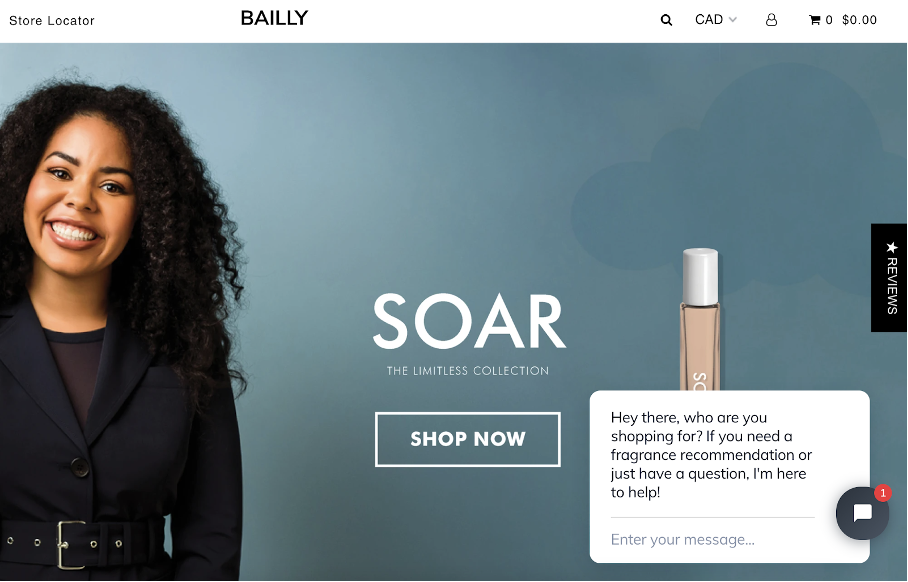
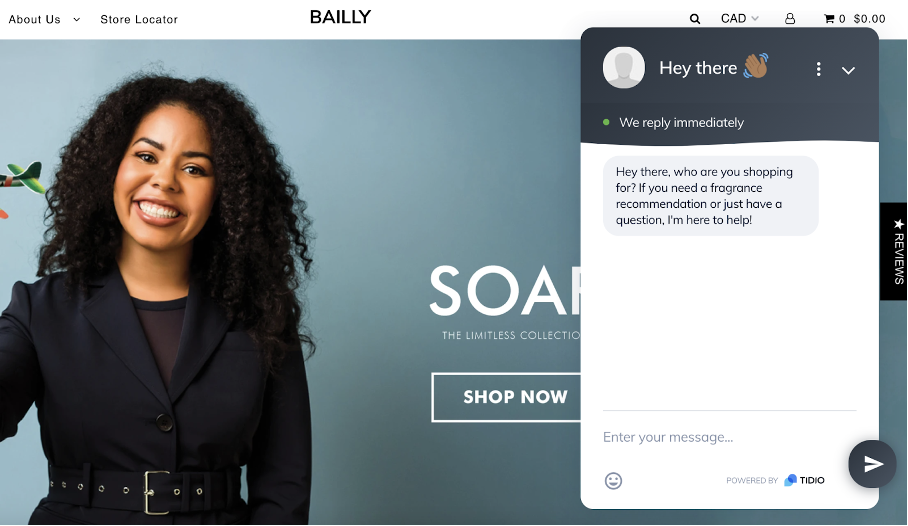
8. Create call-to-action & sign-up buttons
You should never underestimate the power of call-to-action (CTA) buttons: they lead to higher conversion rates and improved site usability.
CTA buttons have to stand out from the rest of your site to be effective. You can think about button size, contrasting colors, and positioning.
You can also use popups to direct your customers’ attention towards your call-to-action.
These templates from OptiMonk is designed around a CTA that encourages users to join an email marketing newsletter.
9. Reassure users that their data is safe
Your ecommerce website isn’t complete until you have a system that protects users’ data and personal security.
And you have to assure customers that your site is safe, reputable, and has the necessary features to protect their privacy.
Taking these actions will ease your customer’s minds:
- Picking a secure platform
- Using an SSL certificate
- Tracking all your orders
- Asking for strong passwords
- Running a PCI Penetration test
10. Use the right tools
There are a staggering amount of apps, programs, and plug-ins that can improve both the functionality and the profitability of your ecommerce business. Make sure you take advantage of such tools (because your competitors sure are).
Tailor your strategies to the data these plug-ins generate. There are specific apps for tracking, managing and improving conversion rates, revenue streams, retention, and retargeting ads.
We’d recommend that you check out our overview of the 38 best Shopify apps for increasing sales and conversions.
Doing so would help you save cost and time and you can run your small business efficiently.
11. Create an FAQ page
An FAQ (Frequently Asked Questions) page is a must-have for any ecommerce store. It’s all about providing quick answers to common questions.
Customers appreciate fast, clear responses, which can significantly enhance their online shopping experience. This can reduce your customer service workload too.
But it’s more than just answering questions. It’s a chance to explain the reason behind your business. Share your story, values, and what makes you unique. This builds trust and connection with your customers.
An effective FAQ page can improve customer satisfaction, boost sales, and strengthen your brand. So, take the time to create a comprehensive and engaging FAQ section on your site. Your customers will thank you!
Check out AG1’s FAQ section for a great example:
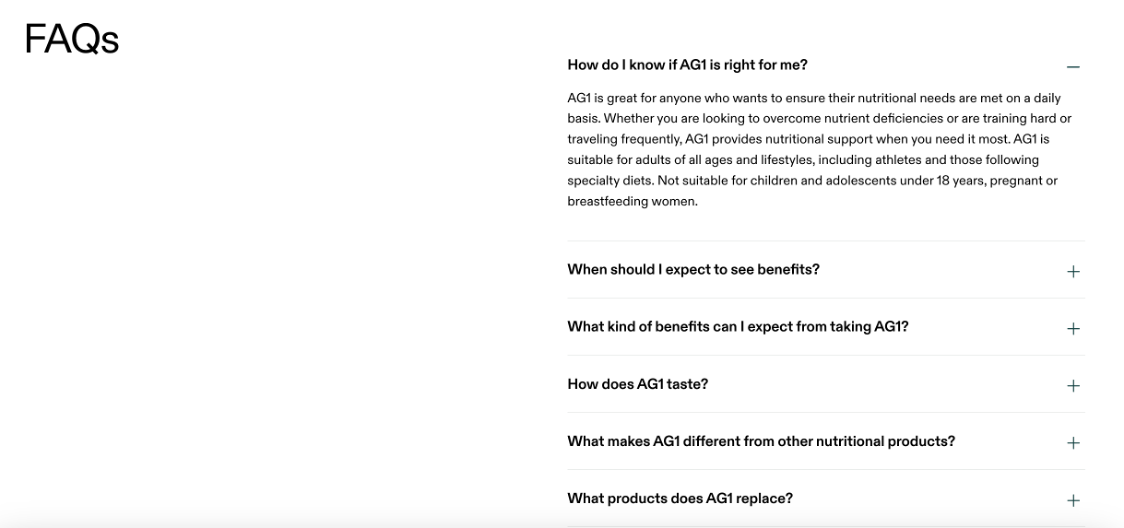
12. Upsell products
Upselling is a powerful strategy to boost your ecommerce sales. It’s about encouraging customers to purchase higher-value items or add-ons.
Think of it as offering a little extra. When a customer is about to buy, suggest a premium version or an additional product that complements their purchase.
Popups are a great tool for upselling. They can appear at the right moment to show new customers related products or upgrades. This timely nudge can lead to more sales and happier customers.

Find out which 5 upsell apps can skyrocket your revenue by watching this video:
13. Offer free shipping
Free shipping is a major draw for customers. By removing shipping costs, you lower the barrier to purchase and make your products more attractive.
Many shoppers abandon their carts due to unexpected shipping fees. Offering free shipping can reduce this and increase conversions.
It can also enhance customer satisfaction and loyalty. Customers feel they’re getting a better deal, which can lead to repeat business.
Consider incorporating the shipping cost into your product prices or setting a minimum order amount for free shipping. This strategy can boost sales and improve the overall shopping experience.
Try promoting your free shipping threshold on a sticky bar so all website visitors are aware of it:
14. Reward customer loyalty
Implementing loyalty programs is a fantastic way to retain existing customers. These programs encourage repeat business by offering rewards for purchases. Customers love feeling valued, and a loyalty program shows them you appreciate their business.
Offer points for every purchase, which can be redeemed for discounts, free products, or special offers.
By making customers feel special, you turn one-time buyers into lifelong, loyal customers. Investing in getting more loyal customers pays off in the long run.
FAQ
How can I build trust with first-time ecommerce visitors?
Use trust signals like SSL certificates, customer reviews, clear return policies, and recognizable payment methods (e.g. PayPal, Apple Pay). Trust badges and real-time support options also help ease purchase anxiety.
How do I segment my email list for better conversions?
Segment by behaviors (e.g., abandoned cart, purchase history), demographics, or engagement level. Personalized campaigns to smaller groups tend to perform much better than generic blasts.
What are the top ecommerce metrics I should be tracking (besides sales)?
Track conversion rate, bounce rate, customer lifetime value (CLTV), average order value (AOV), and cart abandonment rate to get a fuller picture of your store’s performance.
Takeaways
The e-commerce tips and tricks we’ve covered in this article can improve both user experience and conversion rates. They recognize key touchpoints along the customer journey that can make or break a sale.
Use these ecommerce tips to boost sales in your own ecommerce business.
We’ve all got to stay on our toes to keep finding the best ways to run a successful ecommerce business.
Migration has never been easier
We made switching a no-brainer with our free, white-glove onboarding service so you can get started in the blink of an eye.

What should you do next?
Thanks for reading till the end. Here are 4 ways we can help you grow your business:
Boost conversions with proven use cases
Explore our Use Case Library, filled with actionable personalization examples and step-by-step guides to unlock your website's full potential. Check out Use Case Library
Create a free OptiMonk account
Create a free OptiMonk account and easily get started with popups and conversion rate optimization. Get OptiMonk free
Get advice from a CRO expert
Schedule a personalized discovery call with one of our experts to explore how OptiMonk can help you grow your business. Book a demo
Join our weekly newsletter
Real CRO insights & marketing tips. No fluff. Straight to your inbox. Subscribe now
Nikolett Lorincz
- Posted in
- Ecommerce
Partner with us
- © OptiMonk. All rights reserved!
- Terms of Use
- Privacy Policy
- Cookie Policy
Product updates: January Release 2025








